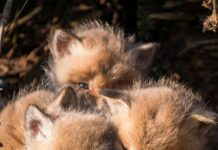A beautiful midsummer evening meant that the 25 people who came along to the Carmarthenshire Bogs Project’s visit to Pyllau Cochion Common, near Horeb, had a fascinating time.
Pyllau Cochion is one of six commons with important bog habitat. The spongy peat meant that wellies were the order of the day and the group set off through the bog, led by Sam Bosanquet from Natural Resources Wales, to discover how bogs were formed and to find out more about the fascinating wildlife that live there.
The landscape of Carmarthenshire has been shaped by people over generations, and commons are examples of sites that have been traditionally managed by local communities. They are also areas that are typically rich in wildlife. Exploring the common allowed us to glimpse a special area of Carmarthenshire that has remained largely unchanged for hundreds of years.
Sam described how bogs are formed over thousands of years – by pushing probes down through the peat it was shown that it was over 6 m deep – that’s 6000 years of peat formation! The group saw close up some of the distinctive range of plants that make up the bog – sphagnum mosses, cotton-grass, cranberry and the carnivorous sundew plant, with sticky droplets that entice and trap flies.
The group learnt that by looking at peat cores from bog habitats like these and the remains of plants and pollen within them that evidence of past changes in climate can be seen. Evidence of volcanoes that erupted thousands of miles away can be seen by the thin layer of volcanic ash (tephra) that falls on, and is captured by, the bog.
Bogs provide us with fresh water by filtering out air pollution and can act as sponges, reducing flood risk through the storage and slow release of rain water. They can help buffer the extremes associated with climate change by storing carbon within the peat. Managing our wetland habitats appropriately has many benefits for wildlife and humans.
Carmarthenshire County Council has successfully secured funding from the Welsh Government Resilient Ecosystems Fund (REF) for a project focusing on six commons in central Carmarthenshire. All the sites are Section 45 commons that the Council is responsible for and all have significant areas of raised bog habitat.
For more information contact: Biodiversity@carmarthenshire.gov.uk;
01558 825390/01267 228727
Help keep news FREE for our readers
Supporting your local community newspaper/online news outlet is crucial now more than ever. If you believe in independent journalism, then consider making a valuable contribution by making a one-time or monthly donation. We operate in rural areas where providing unbiased news can be challenging. Read More About Supporting The West Wales Chronicle





















